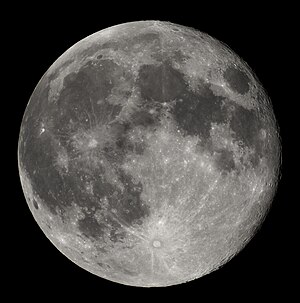
Full Moon view from earth In Belgium (Hamois). Français : Pleine Lune vue de la Terre en Belgique à Hamois. (Photo credit: Wikipedia)
We should be looking forward to warmer, although shorter, nights. How has spring been for you? For us here in the northeast, spring is nowhere to be seen weatherwise. Birds are moving in, though – robins, red-headed woodpeckers, wrens – joining the sparrows, cardinals, and titmice that overwinter. Simply anticipating the warm weather improves my mood.
DUSK Jupiter begins April about halfway up the sky in the west at dusk, in a good position for viewing. Take advantage of it now, as it will be harder to see later in the month. Saturn rises in the east-southeast on April 1st. Venus is barely visible after sunset in the west. To catch a glimpse of Mercury, you need a good view of the eastern horizon, as it is very close to the Sun, rising a few minutes before the Sun. Comet PanSTARRS will be higher in the sky at dusk, but farther from the Sun. That means that while it’s better positioned, it won’t be as bright. Mars is on the other side of the Sun from us, and will not be visible for several months.
ALL NIGHT Saturn is bright in the constellation Libra, rising near sunset. Throughout the month, it will be rising later and later. It is very bright all month, no matter when it rises. It’s brightness is due to the fact that its disk is fully illuminated. Spectacular viewing of its rings and surface with even modest binoculars or telescopes. It is never all that high in the sky, though. To see the positions of Saturn’s moons at any time, go here.
DAWN Mercury rises just a short time before the Sun. While it is visible with binoculars, you won’t likely be able to see it with the naked eye.
MOON In early April, the Moon is waning, rising later each night. At this time of year, you may notice that it is lower in the sky than during winter.
What have you seen in the night sky lately that you’d like to share? Comment below:
